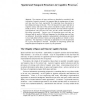180 search results - page 12 / 36 » AURELLIO: A Cognitive Computational Knowledge Representation... |
COGSR
2010
13 years 2 months ago
2010
We propose a formalization of C.G. Jung's theory of personality using a four-dimensional Hilbert-space for the representation of two qubits. The first qubit relates to Jung&#...
IJCINI
2007
13 years 7 months ago
2007
Cognitive Informatics (CI) is a transdisciplinary enquiry of the internal information processing mechanisms and processes of the brain and natural intelligence shared by almost al...
FGR
2011
IEEE
12 years 11 months ago
2011
IEEE
— Despite major advances within the affective computing research field, modelling, analysing, interpreting and responding to naturalistic human affective behaviour still remains...
CMOT
1998
13 years 7 months ago
1998
A programming language which is optimized for modelling multi-agent interaction within articulated social structures such as organizations is described with several examples of it...
BIRTHDAY
1997
Springer
13 years 11 months ago
1997
Springer
The structures of space and time are identified as essential for the realization of cognitive systems. It is suggested that the omnipresence of space and time may have been respons...

